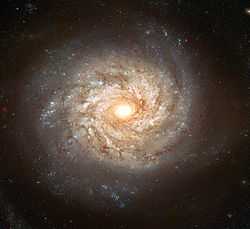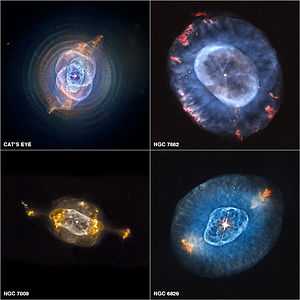| New General Catalogue (NGC) |
|---|
|

Spiral Galaxy NGC 3982 displays numerous spiral arms filled with bright stars, blue star clusters, and dark dust lanes. It spans about 30,000 light years, lies about 68 million light years from Earth and can be seen with a small telescope in the constellation of Ursa Major. |
| Organization |
J. L. E. Dreyer at the
Dunsink Observatory of Dublin University |
|---|
| Data sources |
William Herschel
John Herschel
many others
(revised by Sulentic and Tifft) |
|---|
| Goals |
Survey of non-stellar objects |
|---|
| Data products |
NGC Catalogue |
|---|
|
|
The New General Catalogue of Nebulae and Clusters of Stars (abbreviated as NGC) is a well-known catalogue of deep-sky objects in astronomy compiled by John Louis Emil Dreyer in 1888, as a new version of John Herschel's Catalogue of Nebulae and Clusters of Stars. The NGC contains 7,840 objects, known as the NGC objects. It is one of the largest comprehensive catalogues, as it includes all types of deep space objects and is not confined to, for example, galaxies. Dreyer published two supplements to the NGC, known as the Index Catalogues (abbreviated as IC). The first was published in 1895 and contained 1,520 objects, while the second was published in 1908 and contained 3,866 objects, for a total of 5,386 IC objects.
Objects in the sky of the southern hemisphere are catalogued somewhat less thoroughly, but many were observed by John Herschel or James Dunlop. The NGC had many errors, but a serious if not complete attempt to eliminate them has been initiated by the NGC/IC Project, after partial attempts with the Revised New General Catalogue (RNGC) by Sulentic and Tifft in 1973, and NGC2000.0 by Sinnott in 1988.
Original catalogue
The original New General Catalogue was compiled during the 1880s by John Louis Emil Dreyer using observations from William Herschel and his son John, among others. Dreyer had already published a supplement to Herschel's General Catalogue of Nebulae and Clusters (GC),[1] containing about 1,000 new objects. In 1886, he suggested building a second supplement to the General Catalogue, but the Royal Astronomical Society asked Dreyer to compile a new version instead. This led to the publication of the New General Catalogue in the Memoirs of the Royal Astronomical Society in 1888.[2][3]
Assembling the NGC was a challenge, as Dreyer had to deal with many contradicting and unclear reports, made with a variety of telescopes with apertures ranging from 2 to 72 inches. While he did check some himself, the sheer number of objects meant Dreyer had to accept them as published by others for the purpose of his compilation. Dreyer was a careful transcriber and made few errors himself, but the catalogue nonetheless contained several errors (mostly relating to position and descriptions). He was very thorough in his referencing, which allowed future astronomers to review the original references and publish corrections to the original NGC.[4]
Index Catalogue
The first major update to the NGC is the Index Catalogue of Nebulae and Clusters of Stars (abbreviated as IC), published in two parts by Dreyer in 1895 (IC I,[5] containing 1,520 objects) and 1908 (IC II,[6] containing 3,866 objects). It serves as a supplement to the NGC, and contains an additional 5,386 objects, collectively known as the IC objects. It summarizes the discoveries of galaxies, clusters and nebulae between 1888 and 1907. A list of corrections to the IC was published in 1912.[7]
Revised New General Catalogue
The Revised New Catalogue of Nonstellar Astronomical Objects (abbreviated as RNGC) was compiled by Jack W. Sulentic and William G. Tifft in the early 1970s, and was published in 1973, as an update to the NGC.[8] However, because the update had to be completed in just three summers, it failed to incorporate several previously-published corrections to the NGC data (including corrections published by Dreyer himself), and even introduced new errors.[4]
NGC 2000.0
NGC 2000.0 (also known as the Complete New General Catalogue and Index Catalogue of Nebulae and Star Clusters) is a 1988 compilation of the NGC and IC made by Roger W. Sinnott, using the J2000.0 coordinates.[9][10] It incorporates several corrections and errata made by astronomers over the years. However, it too ignored the original publications and favoured modern (but erroneous) corrections.[4]
NGC/IC Project
The NGC/IC Project is a collaboration formed in 1993. It aims to identify all NGC and IC objects, and collect images and basic astronomical data on them.[11]
Revised New General Catalogue and Index Catalogue
The Revised New General Catalogue and Index Catalogue (abbreviated as RNGC/IC) is a compilation made by Wolfgang Steinicke in 2009.[12][13] It is considered one of the most comprehensive and authoritative treatment of the NGC and IC catalogues.[14][15]
See also
References
- ↑ Dreyer, J. L. E. (1878). "A Supplement to Sir John Herschel's "General Catalogue of Nebulae and Clusters of Stars"" (PDF). Transactions of the Royal Irish Academy 26: 391–426. Bibcode:1878RIATr..26..381D. JSTOR 30079091.
- ↑ Bradt, H. (2004). Astronomy Methods: A Physical Approach to Astronomical Observations. Cambridge University Press. p. 52. ISBN 9780521535519.
- ↑ Dreyer, J. L. E. (1888). "A New General Catalogue of Nebulae and Clusters of Stars, being the Catalogue of the late Sir John F.W. Herschel, Bart., revised, corrected, and enlarged" (PDF). Memoirs of the Royal Astronomical Society 49: 1–237. Bibcode:1888MmRAS..49....1D.
- ↑ 4.0 4.1 4.2 Corwin, H.G. Jr. (12 October 1999). "The NGC/IC Project: An Historical Perspective". The NGC/IC Project. Retrieved 2012-04-22.
- ↑ Dreyer, J. L. E. (1895). "Index Catalogue of Nebulae found in the years 1888 to 1894, with Notes and Corrections to the New General Catalogue". Memoirs of the Royal Astronomical Society 51: 185–228. Bibcode:1895MmRAS..51..185D.
- ↑ Dreyer, J. L. E. (1908). "Second Index Catalogue of Nebulae and Clusters of Stars; containing objects found in the years 1895 to 1907, with Notes and Corrections to the New General Catalogue and to the Index Catalogue for 1888–94" (PDF). Memoirs of the Royal Astronomical Society 59: 105–198. Bibcode:1908MmRAS..59..105D.
- ↑ Dreyer, J. L. E. (1912). "Corrections to the New General Catalogue resulting from the revision of Sir William Herschel's Three Catalogues of Nebulae". Monthly Notices of the Royal Astronomical Society 73: 37–40. Bibcode:1912MNRAS..73...37D. doi:10.1093/mnras/73.1.37.
- ↑ Sulentic, J. W.; Tifft, W. G. (1973). The Revised New Catalogue of Nonstellar Astronomical Objects. University of Arizona Press. ISBN 978-0-8165-0421-3.
- ↑ "NGC2000 - NGC2000.0: Complete New General Catalogue and Index Catalogue". Goddard Space Flight Center. Retrieved 2012-04-22.
- ↑ Sinnott, R. W. (1988). NGC 2000.0: The Complete New General Catalogue and Index Catalogues of Nebulae and Star Clusters. Sky Publishing. ISBN 978-0-933346-51-2.
- ↑ Erdmann, R. E. (2010). "The NGC/IC Project". The NGC/IC Project. Retrieved 2012-04-22.
- ↑ Steinicke, W. (17 January 2012). "Revised New General Catalogue and Index Catalogue". Retrieved 2012-04-22.
- ↑ Steinicke, W. (2010). Observing and Cataloguing Nebulae and Star Clusters: From Herschel to Dreyer's New General Catalogue. Cambridge University Press. ISBN 978-0-521-19267-5.
- ↑ Duerbeck, H. W. (2009). "Book Review: Nebel und Sternhaufen - Geschichte ihrer Entdeckung Beobachtung und Katalogisierung (Steinicke)". Journal of Astronomical History and Heritage 12 (3): 255. Bibcode:2009JAHH...12..255D.
- ↑ Duerbeck, H. W. (2011). "Observing and Cataloguing Nebulae and Star Clusters. From Herschel to Dreyer's New General Catalogue (Steinicke)". Journal of Astronomical History and Heritage 14 (1): 78. Bibcode:2011JAHH...14Q..78D.
External links
 |
Wikimedia Commons has media related to IC objects. |

